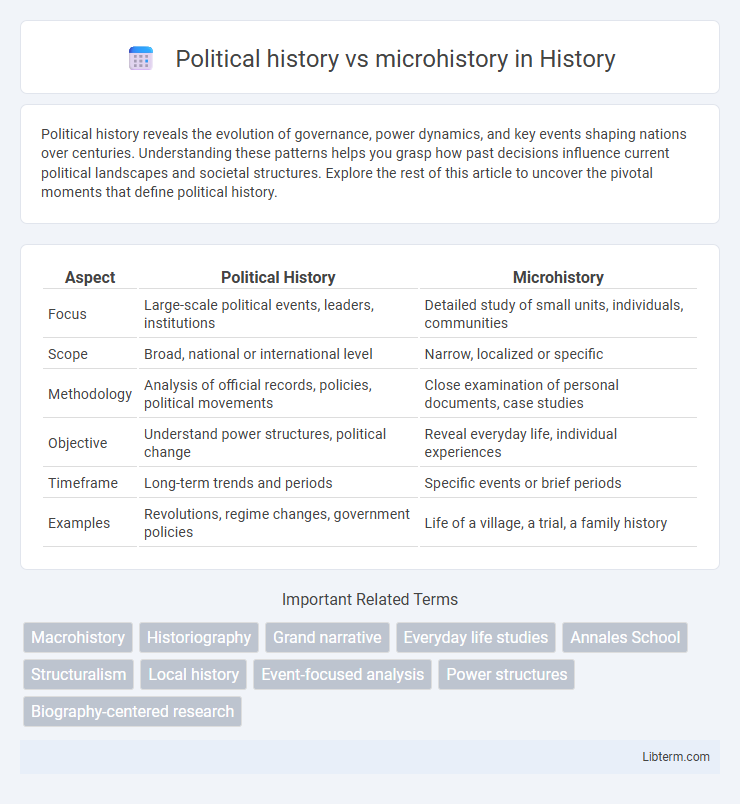Political history reveals the evolution of governance, power dynamics, and key events shaping nations over centuries. Understanding these patterns helps you grasp how past decisions influence current political landscapes and societal structures. Explore the rest of this article to uncover the pivotal moments that define political history.
Table of Comparison
| Aspect | Political History | Microhistory |
|---|---|---|
| Focus | Large-scale political events, leaders, institutions | Detailed study of small units, individuals, communities |
| Scope | Broad, national or international level | Narrow, localized or specific |
| Methodology | Analysis of official records, policies, political movements | Close examination of personal documents, case studies |
| Objective | Understand power structures, political change | Reveal everyday life, individual experiences |
| Timeframe | Long-term trends and periods | Specific events or brief periods |
| Examples | Revolutions, regime changes, government policies | Life of a village, a trial, a family history |
Defining Political History and Microhistory
Political history examines the structures, events, and figures shaping state power, governance, and institutional developments over time, emphasizing broad narratives and macro-level analysis. Microhistory focuses on detailed investigations of specific individuals, communities, or events, uncovering nuanced social, cultural, and political contexts within a limited scope. Defining political history involves analyzing large-scale political processes, while microhistory redefines historical understanding through intensive, localized studies.
Origins and Evolution of Political History
Political history originated as a discipline focused on the study of state institutions, leaders, and major political events, emphasizing power structures and governance over time. Its evolution incorporated more nuanced analyses of ideological movements, policy developments, and institutional reforms, expanding beyond elite actors to include broader societal impacts. In contrast, microhistory emerged to analyze small-scale, localized events or individuals, offering detailed insights that challenge grand narratives of political history by highlighting everyday experiences and marginal voices.
The Emergence of Microhistory
The emergence of microhistory in the late 20th century marked a shift from broad political history to detailed, localized studies of individual lives and events, emphasizing the complexity of social and cultural contexts. Microhistory challenges traditional political narratives by focusing on underrepresented perspectives and everyday experiences, uncovering nuanced interactions that shape historical understanding. This approach uses interdisciplinary methods and archival research to reveal the interplay between micro-level actions and macro-level political structures.
Methodological Approaches: Comparing Scales
Political history employs broad analytical frameworks examining state institutions, power structures, and significant events across regions and periods, relying heavily on official documents and macro-level data. Microhistory focuses on detailed case studies of individuals or small communities, emphasizing thick descriptions and contextual analysis to reveal nuanced social dynamics. Comparing scales, political history generalizes trends, while microhistory offers granular insights, enriching historical understanding through complementary methodological approaches.
Key Figures in Political History and Microhistory
Key figures in political history include influential leaders such as Winston Churchill, Franklin D. Roosevelt, and Mahatma Gandhi, whose decisions shaped national and international policies. In contrast, microhistory focuses on ordinary individuals like Giulio Clovio or Domenico Scandella, revealing broader social dynamics through detailed local narratives. This approach highlights the significance of personal experiences and smaller events to deepen the understanding of historical contexts.
Sources and Evidence: Macro vs. Micro Perspectives
Political history relies heavily on official documents, government records, and institutional archives to construct broad narratives of power, policies, and governance across large populations and extended timeframes. Microhistory emphasizes personal letters, diaries, oral testimonies, and localized artifacts to capture detailed, nuanced experiences of individuals or small communities, revealing underlying social dynamics often overlooked in macro perspectives. The contrasting use of sources highlights macro history's generalizing tendency versus microhistory's commitment to uncovering particular, context-rich evidence that challenges or complements grand historical narratives.
Narratives and Focus: Elites vs. Everyday Life
Political history centers on narratives constructed around elites, state institutions, and major political events, emphasizing power dynamics and policy decisions shaping nations. Microhistory prioritizes everyday life, uncovering the experiences of ordinary individuals through detailed, localized studies to reveal broader social and cultural patterns. This contrast highlights political history's focus on macro-level structures, while microhistory illuminates the nuanced realities within communities and marginalized groups.
Strengths and Limitations of Each Approach
Political history excels in analyzing large-scale events, institutions, and power dynamics, offering comprehensive insights into state governance and policy changes over time. Microhistory provides a detailed examination of specific individuals, communities, or localized events, revealing nuanced social and cultural contexts often overlooked by broader narratives. Political history can overlook individual experiences and everyday life, while microhistory's narrow focus limits its ability to generalize findings to larger historical processes or structures.
Intersections and Synergies Between the Two
Political history and microhistory intersect by providing complementary perspectives: political history offers broad analyses of institutional power and statecraft, while microhistory reveals the localized experiences and individual actions that shape political processes. Synergies emerge as microhistorical studies enrich political narratives with detailed case studies, uncovering the nuanced interactions between ordinary people and political structures. Integrating these approaches deepens understanding of historical dynamics by linking macro-level political developments with micro-level social realities.
Future Directions in Historical Scholarship
Future directions in historical scholarship emphasize integrating political history's broad institutional analyses with microhistory's detailed, localized narratives to create a more comprehensive understanding of past societies. Advances in digital humanities and data analytics enable historians to cross-reference large-scale political events with individual experiences, uncovering nuanced insights into power dynamics and social structures. This interdisciplinary approach promises to redefine historical methodologies by balancing macro-level trends with micro-level human stories.
Political history Infographic

 libterm.com
libterm.com